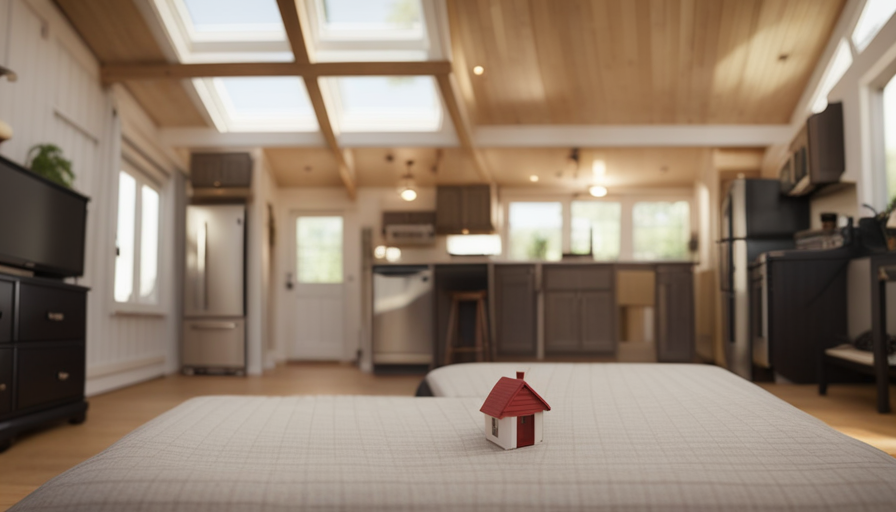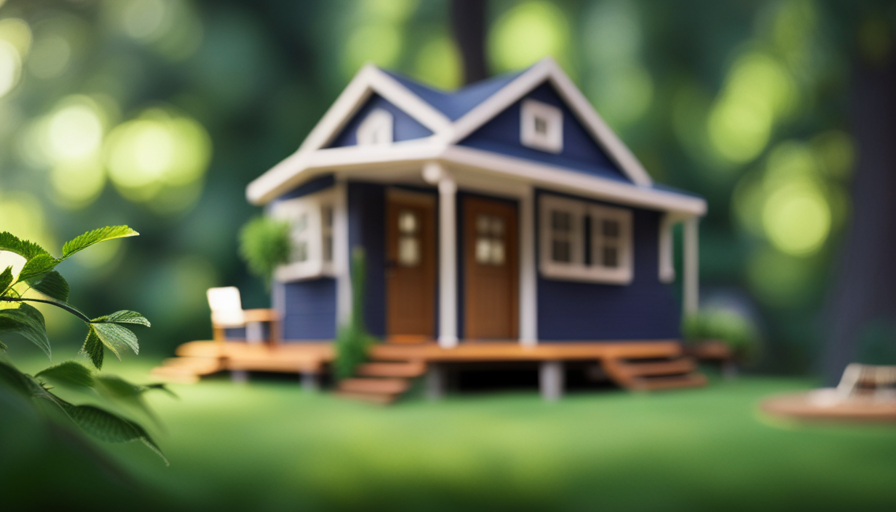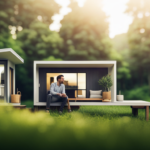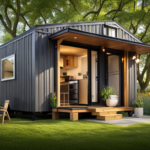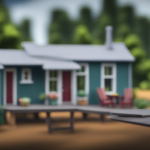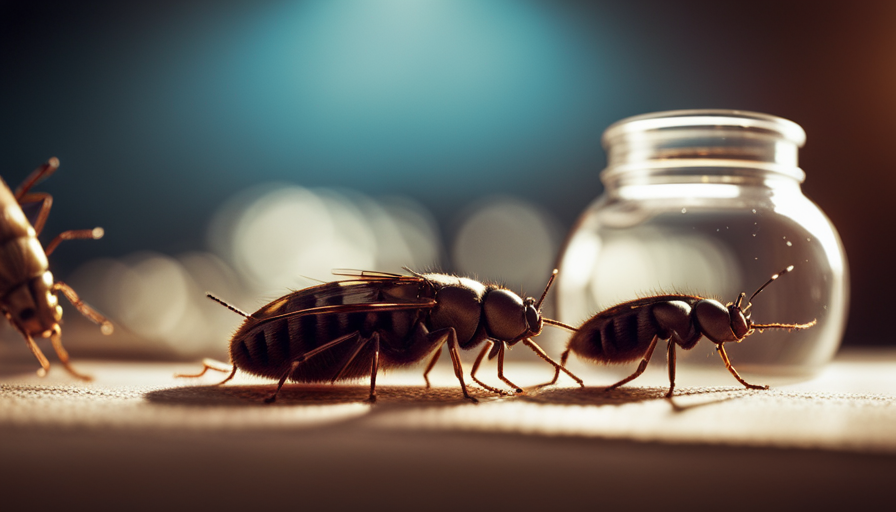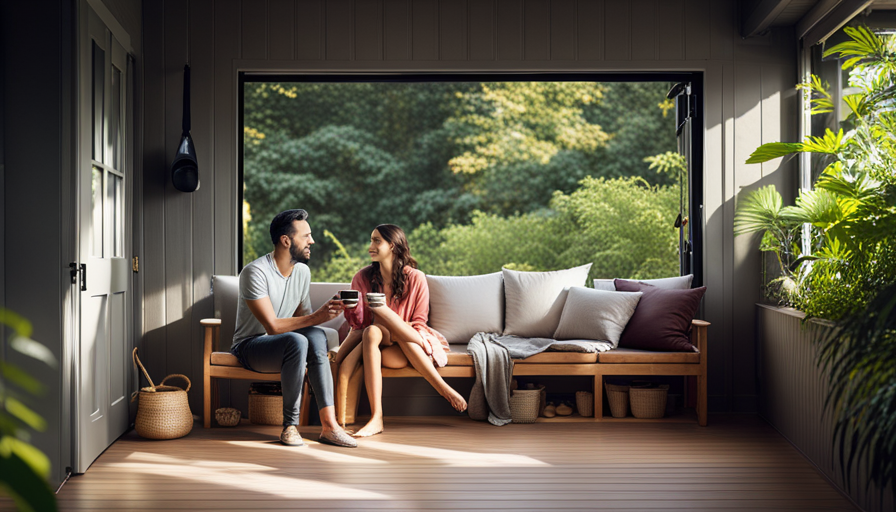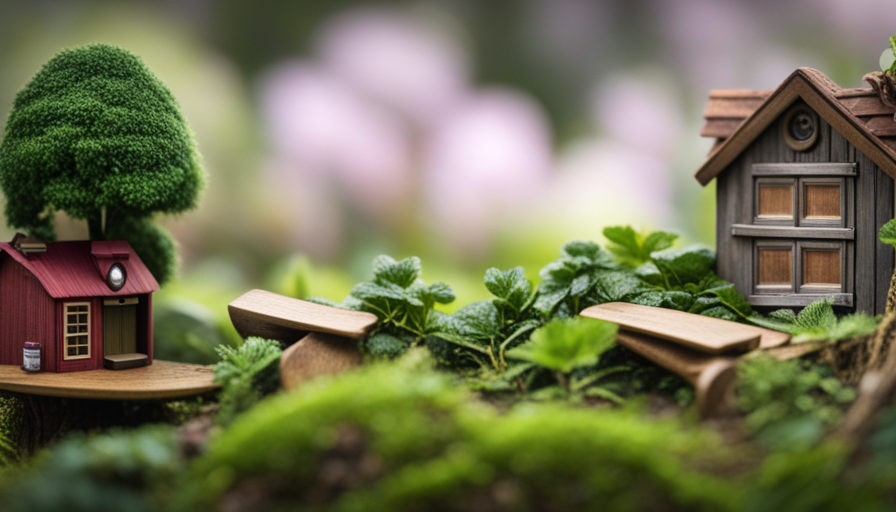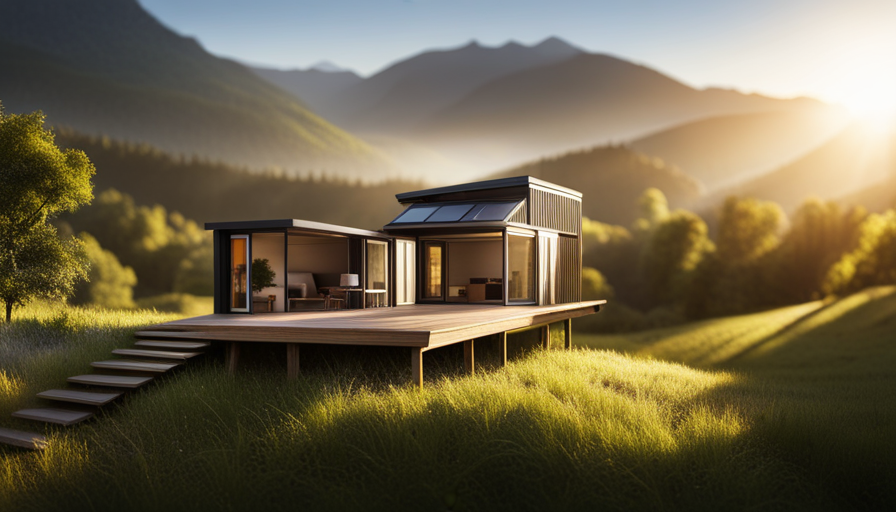Get ready to be wowed as I reveal the remarkable details of a 1000 sq ft tiny house. Get ready to delve into the world of tiny house living, where every square inch is precious.
In this article, I will take you on a tour of the different areas that make up a 1000 sq ft tiny house, from the living area to the kitchen and dining space, sleeping quarters, bathroom facilities, and even the outdoor space.
Now, you might be wondering, how can a house that’s only 1000 sq ft be considered tiny? Well, let me tell you, my friend, when it comes to tiny houses, size is relative. These compact dwellings are designed to maximize functionality and minimize wasted space. So, even though a 1000 sq ft tiny house may not seem small by traditional standards, trust me when I say that every inch of space is utilized to its fullest potential.
So, let’s dive in and discover just how big (or should I say small) a 1000 sq ft tiny house can be.
Key Takeaways
- 1000 sq ft tiny houses maximize functionality and minimize wasted space
- Compact gardens and outdoor seating areas optimize space
- Clever storage solutions and multi-purpose furniture are essential in the interior layout
- Efficient appliances and storage solutions are important in the kitchen and bathroom areas
Understanding Tiny House Living
Living in a tiny house is like entering a cozy and efficient world where every square foot counts! Understanding the minimalist lifestyle is key to embracing this unique living arrangement.
By downsizing to a smaller space, you can simplify your life and focus on what truly matters. The benefits of downsizing are numerous, including reduced expenses, lower maintenance, and a smaller carbon footprint. It allows you to prioritize experiences over material possessions and encourages a more sustainable way of living.
Now, let’s explore the dimensions of a 1000 sq ft tiny house and how it can accommodate your needs while still providing a comfortable and functional living space.
Dimensions of a 1000 sq ft Tiny House
In discussing the dimensions of a 1000 sq ft tiny house, I’ll provide information on its exterior measurements, interior layout, and room configurations.
The exterior measurements of a 1000 sq ft tiny house typically range from 20 feet by 50 feet to 25 feet by 40 feet, depending on the design and shape of the house.
The interior layout of a 1000 sq ft tiny house usually includes a living area, kitchen, bathroom, and one or two bedrooms, with some variations depending on the builder’s design choices.
The room configurations in a 1000 sq ft tiny house can be customized to suit individual preferences, with options for open floor plans, loft spaces, or multi-purpose rooms to maximize the use of space.
Exterior Measurements
Outside the walls of a 1000 sq ft tiny house, its dimensions expand like a blooming flower. The exterior design of a tiny house plays a crucial role in maximizing space and creating a visually appealing structure. To make the most of the limited square footage, incorporating clever landscaping ideas can enhance the overall aesthetic of the property.
Here are three key elements to consider:
-
Compact gardens: Utilize vertical space for growing plants, such as installing trellises or using hanging baskets. Incorporate raised beds or container gardens to maximize the use of available ground space.
-
Outdoor seating areas: Create cozy nooks or small patios to enjoy the surrounding nature. Use compact furniture or built-in seating to optimize the available space.
-
Multi-functional structures: Incorporate features like pergolas or awnings that can provide shade and also serve as additional storage areas.
Transitioning into the subsequent section about the interior layout, we can explore how to optimize space within the tiny house.
Interior Layout
When designing the interior layout, it’s crucial to focus on maximizing every inch of available space. In a 1000 sq ft tiny house, efficient interior design is key to create a functional and comfortable living space.
Careful consideration must be given to space utilization in order to accommodate all necessary amenities without compromising on comfort. This involves clever storage solutions, such as built-in cabinets and multi-purpose furniture, to make the most of limited square footage. Additionally, open floor plans and strategic placement of windows can create an illusion of spaciousness.
By carefully planning the interior layout, it is possible to create a tiny house that feels much larger than its actual size. Transitioning to the subsequent section about room configurations, different layouts can be explored to further optimize the use of space.
Room Configurations
Room configurations are an important aspect of designing a functional and comfortable living space in a small house. When dealing with a 1000 sq ft tiny house, careful consideration must be given to room size and furniture placement to maximize usability. Here are three key factors to keep in mind:
-
Optimize the layout: With limited space, it’s crucial to plan the placement of rooms strategically. Consider the flow of movement and ensure that each room serves its purpose efficiently.
-
Utilize multi-functional furniture: In a small house, every inch counts. Choose furniture pieces that serve multiple purposes, such as a sofa that can convert into a bed or a coffee table with built-in storage.
-
Create open, airy spaces: To avoid a cramped feeling, incorporate design elements that create the illusion of space. Use light-colored walls, mirrors, and ample lighting to make the rooms feel more spacious.
As we move onto the next section about the living area, we’ll explore how to make the most of this central space in a 1000 sq ft tiny house.
Living Area
The living area of a 1000 sq ft tiny house feels surprisingly spacious, thanks to clever tiny house design and furniture arrangement. In order to maximize the limited space available, designers often utilize multi-functional furniture that can serve multiple purposes. For example, a sofa can double as a bed, and a coffee table can convert into a dining table. Additionally, built-in storage solutions are key to keeping the living area organized and clutter-free. By incorporating shelves, cabinets, and hidden compartments, every inch of space is utilized efficiently.
As we transition to the subsequent section about kitchen and dining space, it’s important to note that the living area seamlessly flows into these areas, creating a cohesive and functional living space.
Kitchen and Dining Space
In the kitchen and dining space of a tiny house, one of the key points to consider is the use of compact appliances. These space-saving appliances are designed to fit seamlessly into smaller areas without compromising functionality.
Additionally, efficient storage solutions are essential in maximizing the limited space available in a tiny house. From cleverly designed cabinets and drawers to creative storage solutions, every inch of space should be utilized efficiently.
Lastly, when it comes to dining options, flexibility is key. Consider incorporating multi-purpose furniture that can be used for both dining and other activities, such as a foldable dining table or a kitchen island with seating.
Compact Appliances
Compact appliances in a tiny house this size would allow you to cook gourmet meals while saving space. With the use of compact furniture and space-saving techniques, you can maximize the functionality of your kitchen and dining space. Here is a table showcasing some essential compact appliances that would fit perfectly in a 1000 sq ft tiny house:
| Appliance | Size |
|---|---|
| Compact stove | 24 inches wide |
| Mini refrigerator | 4.4 cubic feet |
| Countertop dishwasher | 18 inches wide |
| Combination microwave oven | 0.9 cubic feet |
| Compact washer and dryer | 24 inches wide |
These appliances are designed to be smaller in size without compromising their functionality. They fit seamlessly into the limited space available, allowing you to enjoy the convenience of modern appliances without sacrificing valuable square footage. With compact appliances like these, you can create a functional and efficient kitchen in your tiny house. Efficient storage solutions complement these appliances, ensuring that every inch of your space is utilized effectively.
Efficient Storage Solutions
Maximize your storage space with efficient solutions that optimize every inch of your kitchen and dining area. When it’s about living in a 1000 sq ft tiny house, efficient organization and clever storage are key to keeping everything in order.
In the kitchen, consider installing shelves that slide out, making it easy to access items stored in the back. Utilize vertical space by hanging pots and pans from a ceiling rack, freeing up precious cabinet space. Magnetic knife strips and spice racks can also be mounted on the wall, keeping countertops clutter-free.
In the dining area, opt for a table that can be folded down when not in use, allowing for additional space for other activities.
Transitioning into the subsequent section on dining options, let’s explore how to make the most of your small eating area.
Dining Options
To fully enjoy your dining experience in your cozy abode, explore creative options that optimize your small eating area. One way to maximize space is by incorporating outdoor seating into your tiny house design. This allows you to expand your dining area and enjoy meals in the fresh air. Additionally, consider incorporating multi-functional furniture that can be easily converted into a dining table when needed. Another option is to utilize foldable tables and chairs that can be tucked away when not in use.
Meal preparation in a small space can be challenging, but with the right organization and storage solutions, it can be efficient and enjoyable. Consider utilizing compact appliances and clever storage solutions to make the most of your kitchen area. Install shelves and hooks to keep your cooking utensils and ingredients within easy reach. Utilize vertical storage options to save space and keep your counters clutter-free.
Transitioning to the subsequent section about ‘sleeping quarters’, it is important to optimize your small space to ensure a comfortable and restful night’s sleep.
Sleeping Quarters
In the discussion of sleeping quarters in a tiny house, three key points to consider are loft beds, Murphy beds, and creative sleeping arrangements.
Loft beds are elevated beds that maximize vertical space and can be accessed by a ladder or stairs.
Murphy beds are foldable beds that can be concealed during the day, providing a versatile and space-saving solution.
Lastly, creative sleeping arrangements can include convertible furniture or innovative designs that optimize space and provide comfortable sleeping options.
Loft Beds
Imagine climbing up into your cozy loft bed in your 1000 sq ft tiny house, where you can stretch out and dream big in a space-saving sleeping area. Loft bed designs are crucial in maximizing vertical space in a tiny house.
These beds are elevated, allowing for ample space underneath to be utilized for other purposes such as a workspace or storage area. The loft bed can be customized to fit your needs, with various designs available, including built-in shelves or drawers for additional storage.
The elevated platform provides a sense of privacy and separation from the rest of the living area, creating a cozy and intimate sleeping space.
Transitioning to the subsequent section about ‘murphy beds’, let’s explore another innovative sleeping solution that can further optimize your 1000 sq ft tiny house.
Murphy Beds
Climb into the hidden sanctuary of a Murphy bed, where you can seamlessly transform your living area into a dreamy bedroom.
Murphy beds are a fantastic solution for tiny houses as they provide a space-saving alternative to traditional beds. These beds can be easily folded up and stored against the wall when not in use, maximizing space and allowing for a more functional living area during the day.
Murphy bed alternatives, such as sofa beds or wall beds, offer even more versatility, allowing you to utilize the same space for multiple purposes. With these options, you can effortlessly switch between a cozy bedroom and a comfortable seating area, making the most of your 1000 sq ft tiny house.
Transitioning into the subsequent section about creative sleeping arrangements, let’s explore even more innovative ways to optimize your sleeping space.
Creative Sleeping Arrangements
Discover the endless possibilities of arranging your sleep space creatively, transforming it into a sanctuary that invites relaxation and rejuvenation. Here are four creative sleeping arrangements that’ll maximize space in your 1000 sq ft tiny house:
-
Loft Beds: Utilize vertical space by installing a loft bed, allowing for a separate sleeping area while freeing up floor space below for storage or other activities.
-
Wall Beds: Also known as Murphy beds, these space-saving solutions can be folded up against the wall during the day, providing extra floor space. They can be easily pulled down at night for a comfortable sleep.
-
Sofa Beds: Opt for a sofa that can be transformed into a bed when needed. This multifunctional piece of furniture allows for both seating and sleeping arrangements, maximizing space.
-
Bunk Beds: Ideal for tiny houses with multiple occupants, bunk beds provide efficient use of vertical space, allowing for more floor area to be utilized for other purposes.
Now, let’s explore the innovative bathroom facilities in a 1000 sq ft tiny house.
Bathroom Facilities
Step into the bathroom of your 1000 sq ft tiny house and you’ll find a compact yet functional space that maximizes every square inch. The bathroom design in a tiny house prioritizes efficiency, with clever storage solutions and multi-purpose fixtures. Every inch is utilized to ensure that you have all the necessary amenities without sacrificing comfort.
Water conservation is also a key consideration in the bathroom design, with low-flow fixtures and efficient plumbing systems. Despite the smaller footprint, you’ll find that the bathroom in your tiny house has everything you need, including a toilet, sink, and shower. The space may be small, but it is designed to meet your needs without compromising on functionality.
Moving on to the subsequent section about outdoor space, you’ll find that the tiny house is also thoughtfully designed to incorporate a cozy and inviting outdoor area.
Outdoor Space
When you venture outside your compact living space, you’ll be delighted to find that the outdoor area of your 1000 square foot abode is specifically designed to be a cozy and inviting retreat, perfect for relaxation and enjoying the fresh air.
Did you know that studies have shown spending time outdoors can reduce stress and improve overall well-being?
The outdoor design of your tiny house includes carefully chosen elements to maximize the use of the limited space. You’ll find a well-designed patio or deck area that seamlessly extends your living space outdoors.
This outdoor space is equipped with comfortable seating and a small dining area, allowing you to entertain guests or simply enjoy a meal outside.
In addition, the outdoor amenities may include a compact garden or green space, providing you with the opportunity to cultivate your own plants and connect with nature.
Frequently Asked Questions
How much does it cost to build a 1000 sq ft tiny house?
To build a 1000 sq ft tiny house, the cost of materials can range from $30,000 to $100,000, depending on the quality of materials used. The construction timeline typically takes around 3 to 6 months, depending on factors such as weather conditions and the complexity of the design.
It’s important to carefully plan and budget for the project to ensure a smooth and successful construction process.
Can a 1000 sq ft tiny house be built on wheels?
Yes, a 1000 sq ft tiny house can be built on wheels. However, it’s important to consider building codes and zoning regulations. These regulations vary by location and may dictate the maximum size, weight, and height of a mobile structure. It’s crucial to consult local authorities and adhere to these guidelines to ensure compliance and safety when constructing a tiny house on wheels.
Are there any legal restrictions on living in a 1000 sq ft tiny house?
Living in a 1000 sq ft tiny house is subject to legal restrictions and zoning regulations. Some may argue that these rules limit personal freedom, but it’s important to understand that these regulations are in place to ensure safety, sanitation, and harmony with the surrounding community. Local authorities enforce zoning codes to control land use and protect property values. Compliance with these regulations is crucial to avoid legal issues and maintain a positive living experience.
How long does it typically take to build a 1000 sq ft tiny house?
Typically, it takes around 3-6 months to build a 1000 sq ft tiny house. To maximize space in such a small area, efficient design is crucial.
Here are some tips:
- Prioritize multi-functional furniture.
- Utilize vertical space with loft beds or storage.
- Opt for open floor plans.
- Incorporate clever storage solutions like built-in cabinets or under-stair storage.
These strategies will help create a more spacious and functional living environment within the limited square footage.
What are some common challenges faced when living in a 1000 sq ft tiny house?
Living in a 1000 sq ft tiny house poses several common challenges. One major challenge is space management. With limited square footage, it’s crucial to optimize every inch of available space. This requires careful organization and creative solutions to maximize storage and functionality.
Additionally, living in a small space can feel cramped and may require adjustments to daily routines and activities. Proper planning and efficient use of space are essential to overcome these challenges.
Conclusion
In conclusion, a 1000 sq ft tiny house offers ample living space for a minimalist lifestyle. The dimensions of the house are carefully designed to maximize functionality and convenience.
The living area provides a comfortable space for relaxation and entertainment, while the kitchen and dining area allow for cooking and enjoying meals. The sleeping quarters offer privacy and comfort, and the bathroom facilities are compact yet functional.
Additionally, the outdoor space provides opportunities for outdoor activities and relaxation. Overall, a 1000 sq ft tiny house offers a practical and efficient living solution.
Hi, I’m Emma. I’m the Editor in Chief of Tiny House 43, a blog all about tiny houses. While tree houses are often associated with childhood, they can be the perfect adult retreat. They offer a cozy space to relax and unwind, surrounded by nature. And since they’re typically built on stilts or raised platforms, they offer stunning views that traditional homes simply can’t match. If you’re looking for a unique and romantic getaway, a tree house tiny house might just be the perfect option.
